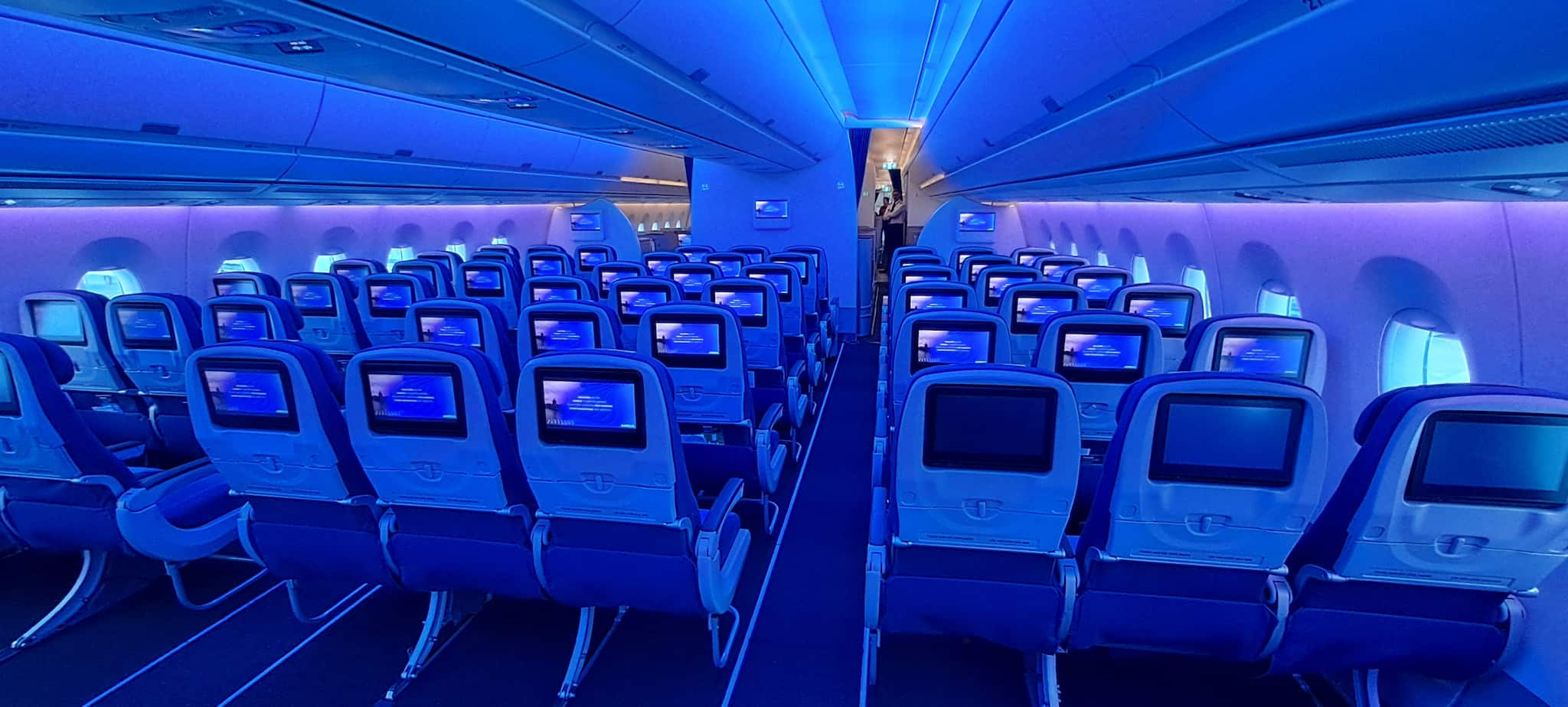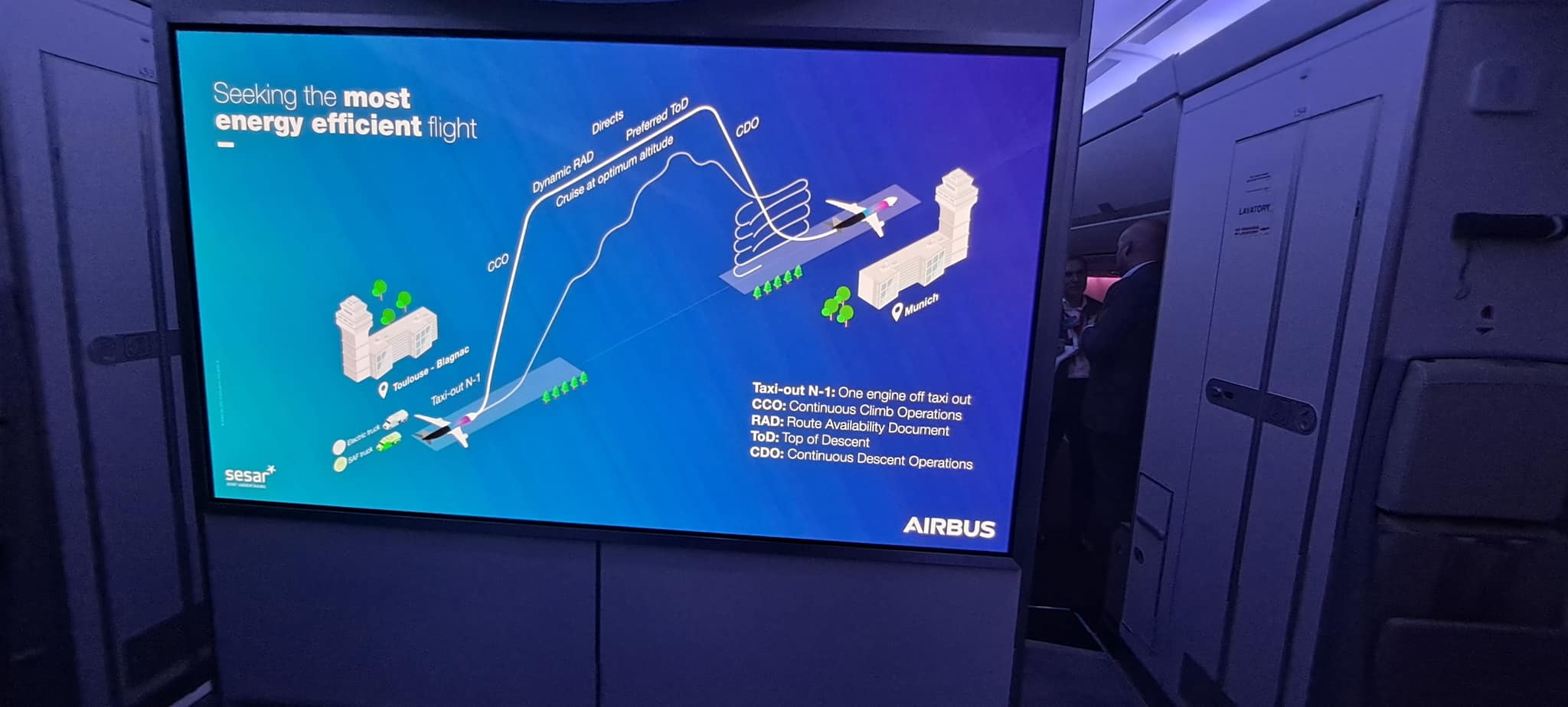
Airbus converted one of its A350 XWB aircraft into the ‘Airbus Explorer’ to showcase its innovations (Picture Credit: Ameya Joshi)
More often than not, one hears the click-click of seat belts being unfastened the moment an aircraft touches down. In some parts of the world, India included, passengers rush to deplane as soon as the aircraft halts – even if it is to wait for a bay.
When India’s civil aviation operations restarted in May 2020 after the first COVID-19 wave, it was a challenge to implement row-wise deplaning. While passengers largely followed the system in the initial days, even complying with mandatory mask-wearing became tough, until it was dropped completely.
The future, however, could be different.
Also Read | Time to refresh airline on-time performance metric for level playing field
Airbus is introducing a solution to aid orderly and safe disembarking and avoid crowding of the aisles, among other things, as it seeks to sell more planes across the globe.
How is Airbus doing it? The disembarking solution is based on a novel lighting design based on standard traffic principles. The aircraft is designed to use cabin illumination of different combinations to indicate the rows that are designated to disembark next.
Passengers tend to follow visual cues better than the verbal cues by the cabin crew and this is expected to ensure an orderly and rush-free departure from the plane.
 (Picture Credit: Ameya Joshi)
(Picture Credit: Ameya Joshi)
The programmed scenarios enable multi- or single-colour projection with specific time intervals in a certain direction – either front to back or back to front. The colour schemes can be customised to make it similar to the airline’s brand, if it wants to move away from the standard traffic light colours.
Also Read | How Air India under the Tatas soared to the top of the punctuality charts
Airbus converted one of its A350 XWB aircraft to showcase the innovations that it is working on and offering its existing and new customers. Named Airbus Explorer, the aircraft highlighted the future of flying on a special flight from Toulouse to Munich.
The aircraft has many more features – some of which are already available as options.
Eco-friendly carpets, connected galleys
Manufactured with 100 percent regenerated nylon yarn, eco-friendly carpets on the plane can be produced in any colour. The carpet itself can also be recycled.
The connected-galley programmes use the Internet of Things (IoT) to allow predictive catering and transparent inventory management through pre-ordering by passengers and usage data, helping reduce waste. This IoT platform links in real-time the core cabin components (galleys, meal trolleys, seats, overhead bins) and allows data exchange that the crew can track on their portable electronic devices.
As waste generation is expected to increase with more flights, Airbus is looking at ways to automatically capture data of on-board meal consumption and the amount of unused food and drinks.
Also Read | Old planes and wet leases drive new beginnings for India’s airlines
By integrating such information in an artificial intelligence-driven system, airlines could optimise their catering services and manage after-meal disposal better, potentially leading to a double-digit lowering of their carbon-dioxide emissions through weight reduction and fuel savings.
The seats are fitted with sensors linked to the system, which help the crew to know if seat belts are fastened and if the seat is reclined or upright. Not just that, the evolving system has the ability to capture data related to the positions of each seat during a flight, which could enable the development of ergonomic seats and better customer experience overall.
More seats coming in
As the technology advancements are incorporated, Airbus has come up with new side panels that add 4 inches of space, helping to make economy class seating 10 abreast from the current nine. While this will help airlines add more seats, further reducing the cost per seat, it will come at the cost of reducing the seat width and Airbus departing from its 18-inch seat-width philosophy.
The changes include an option to provide electronic-dimmable windows (similar to those on the 787) which helps the crew control the windows to block sunlight. This contributes to weight reduction because the window shades are removed completely.
The sustainable flight
The special flight from Toulouse to Munich showcased efficiency and the possible way forward for the industry. This involved one-engine taxi out, Continuous Climb Operations and Continuous Descent Operations and flying at the preferred altitude. Data from flight-tracking website Flightradar24 showed how the flight went exactly as planned.
 (Picture Credit: Ameya Joshi)
(Picture Credit: Ameya Joshi)
However, in the end came a reminder about how well the entire ecosystem must work together in order to move towards lower emissions: upon landing, the flight had to wait for a gate at Munich airport.
The author is in Munich on invitation of Airbus
